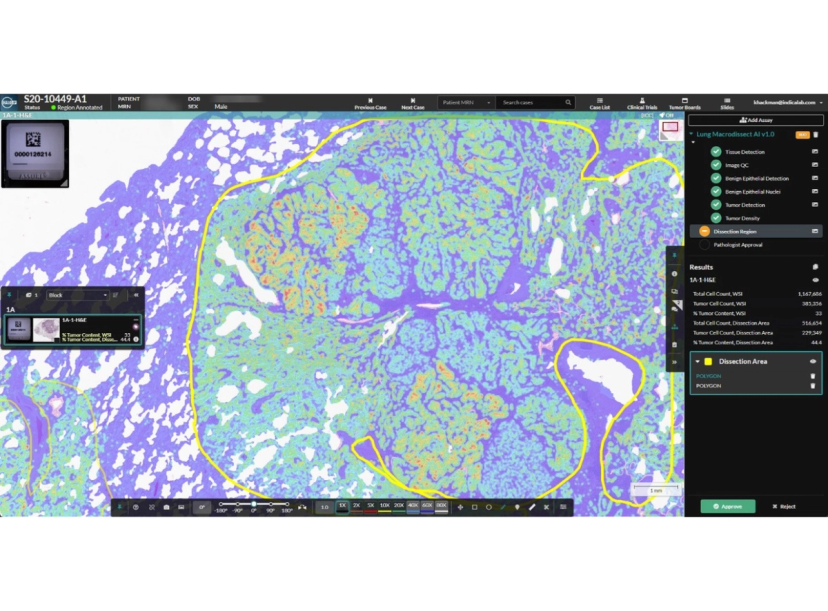Indica Labs announces launch of AI-powered macrodissection suite to advance molecular pathology workflows
Streamlining the macrodissection annotation process for both primary and metastatic non-small cell lung cancer cases
1 Aug 2024
Lung Macrodissect AI is seamlessly deployed in HALO AP®, quantifies tumor content, streamlines tumor annotation, and ensures specimen quality for downstream analysis
Indica Labs, a leading provider of AI-powered digital pathology solutions, has announced the launch of Lung Macrodissect AI, a groundbreaking tool that revolutionizes slide macrodissection and molecular pathology workflows. Lung Macrodissect AI represents a significant leap forward for the integration of artificial intelligence with digital pathology by offering pathologists a streamlined macrodissection workflow that minimizes human error and improves efficiency.
Tumor content estimation and macrodissection are critical steps in molecular pathology, involving the assessment of tumor content within a sample and the precise isolation and removal of tumor regions for downstream molecular analysis. Existing manual methods are subjective, error-prone, labor-intensive, and lack auditability.
Indica Labs’ HALO Macrodissection Solutions suite addresses these challenges by quantifying tumor content across the entire whole slide image and generating real-time information about the quantity of tumor cells within annotated regions. Tumor cell density heatmaps highlight tumor-rich regions, aiding the annotation process. Lung Macrodissect AI quantifies and standardizes tumor content assessment, reducing subjectivity and errors while streamlining the macrodissection annotation process for both primary and metastatic non-small cell lung cancer cases.
Lung Macrodissect AI integrates seamlessly into HALO AP®, the enterprise digital pathology platform from Indica Labs, and can be combined with the Tissector line of robotic macrodissectors from it's partner, Xyall, for a fully automated and audited workflow. This integration enhances the accuracy of the macrodissection process and increases throughput and operational efficiency, freeing pathologists to focus on more complex tasks. The tool can also be used to guide and standardize manual macrodissection workflows.
We’re excited to offer pathologists an alternative to the current time-consuming, labor-intensive process of macrodissection. Our macrodissection AI models significantly advance the field of molecular pathology. Lung Macrodissect AI is part of a larger suite of macrodissection tools, with additional product launches planned for colon, breast, and prostate. These products significantly enhance macrodissection workflows and make genetic testing more accessible, accurate, and affordable.
Steven Hashagen CEO of Indica Labs
Beyond highlighting cancerous tissue, Lung Macrodissect AI calculates the total number of tumor cells present within an annotated region of interest (ROI) and determines the percentage of tumor present in all annotated ROIs. This ensures that only adequately concentrated specimens are sent for expensive downstream genetic sequencing and molecular testing. By standardizing the enrichment process, Lung Macrodissect AI improves the overall quality and reliability of macrodissection workflows while streamlining the process in its entirety and enhancing efficiency.
Clinical validation was conducted on 317 primary and metastatic whole slide images from an external site that were previously unseen to the algorithm. Comparing five pathologists’ tumor content estimations with and without assistance from Lung Macrodissect AI revealed significant improvements in agreement and consistency when aided by the algorithm. Without AI assistance, the consistency between pathologists (ICC) was relatively low at 0.45. The agreement measure (Fleiss’ kappa) when specimens were binarized using a 20% tumor content cut-off, the minimum requirement for most molecular tests, was also low at 0.27. With AI assistance, the ICC score increased to 0.75, and the Fleiss’ kappa statistic rose to 0.66, indicating a substantial and significant improvement in consistency of tumor content estimation across pathologists.
Lung Macrodissect AI is available in the HALO AP® platform, trusted for its robust suite of tools for annotation, collaboration, and image analysis. HALO AP® offers seamless interoperability and compatibility with a wide range of file types, LIS | LIMS, and HALO Clinical AI and third-party AI, ensuring flexibility and ease of use in diverse laboratory environments.
Want the latest science news straight to your inbox? Become a SelectScience member for free today>>
